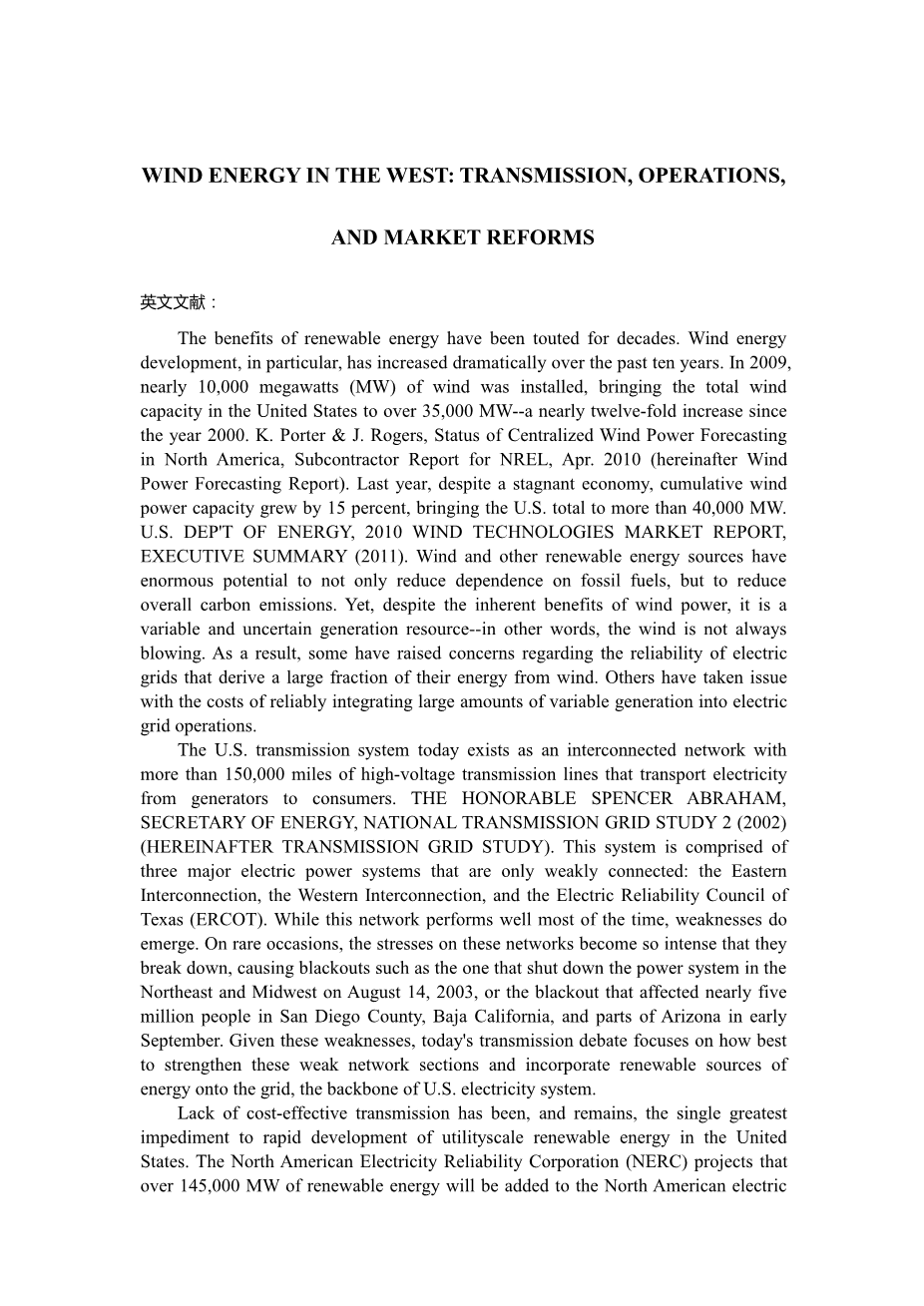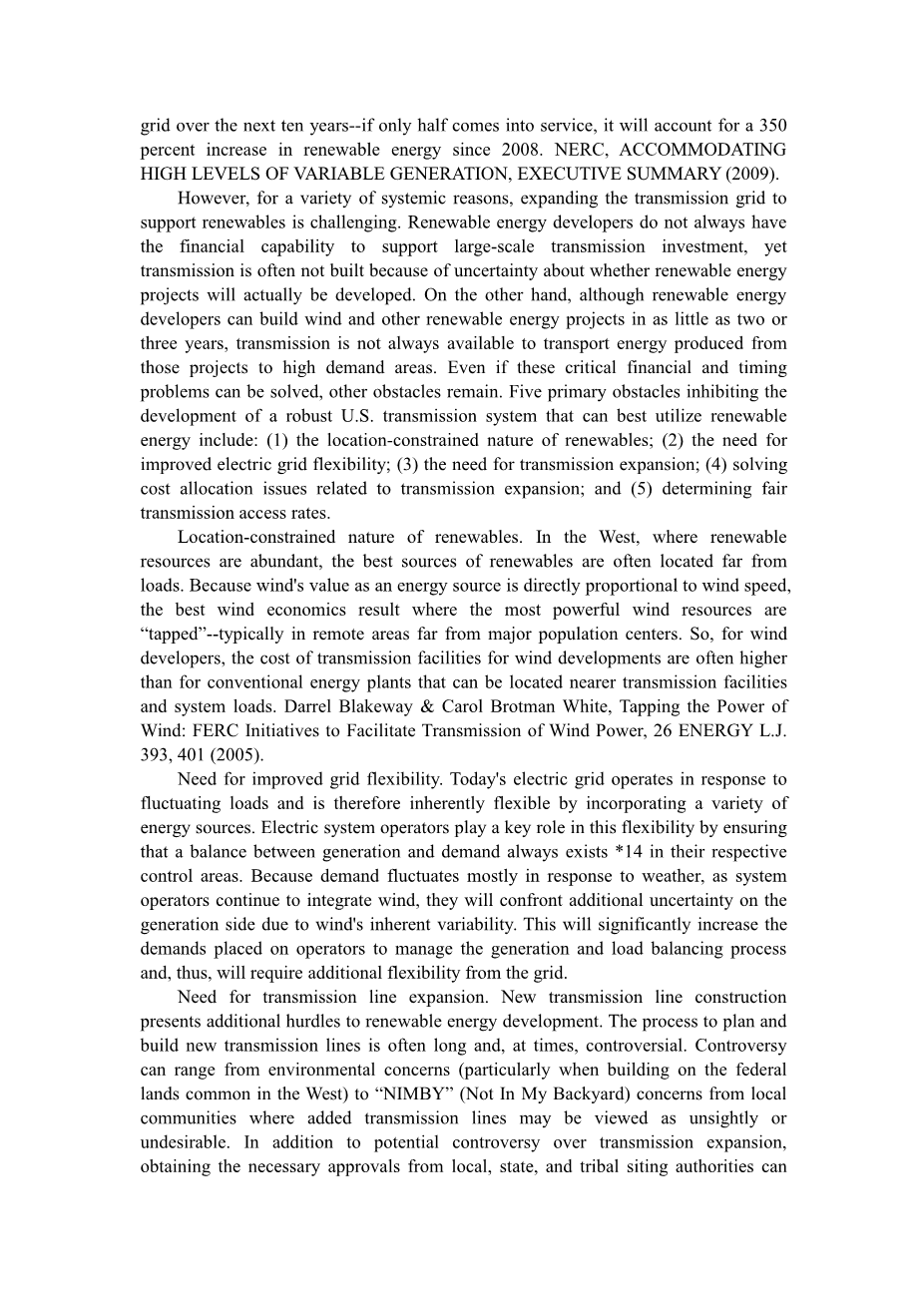英语原文共 4 页,剩余内容已隐藏,支付完成后下载完整资料
西方国家的风能:传输、运营和市场改革
英文文献翻译:
WIND ENERGY IN THE WEST: TRANSMISSION, OPERATIONS, AND MARKET REFORMS
英文文献:
The benefits of renewable energy have been touted for decades. Wind energy development, in particular, has increased dramatically over the past ten years. In 2009, nearly 10,000 megawatts (MW) of wind was installed, bringing the total wind capacity in the United States to over 35,000 MW--a nearly twelve-fold increase since the year 2000. K. Porter amp; J. Rogers, Status of Centralized Wind Power Forecasting in North America, Subcontractor Report for NREL, Apr. 2010 (hereinafter Wind Power Forecasting Report). Last year, despite a stagnant economy, cumulative wind power capacity grew by 15 percent, bringing the U.S. total to more than 40,000 MW. U.S. DEPT OF ENERGY, 2010 WIND TECHNOLOGIES MARKET REPORT, EXECUTIVE SUMMARY (2011). Wind and other renewable energy sources have enormous potential to not only reduce dependence on fossil fuels, but to reduce overall carbon emissions. Yet, despite the inherent benefits of wind power, it is a variable and uncertain generation resource--in other words, the wind is not always blowing. As a result, some have raised concerns regarding the reliability of electric grids that derive a large fraction of their energy from wind. Others have taken issue with the costs of reliably integrating large amounts of variable generation into electric grid operations.
The U.S. transmission system today exists as an interconnected network with more than 150,000 miles of high-voltage transmission lines that transport electricity from generators to consumers. THE HONORABLE SPENCER ABRAHAM, SECRETARY OF ENERGY, NATIONAL TRANSMISSION GRID STUDY 2 (2002) (HEREINAFTER TRANSMISSION GRID STUDY). This system is comprised of three major electric power systems that are only weakly connected: the Eastern Interconnection, the Western Interconnection, and the Electric Reliability Council of Texas (ERCOT). While this network performs well most of the time, weaknesses do emerge. On rare occasions, the stresses on these networks become so intense that they break down, causing blackouts such as the one that shut down the power system in the Northeast and Midwest on August 14, 2003, or the blackout that affected nearly five million people in San Diego County, Baja California, and parts of Arizona in early September. Given these weaknesses, todays transmission debate focuses on how best to strengthen these weak network sections and incorporate renewable sources of energy onto the grid, the backbone of U.S. electricity system.
Lack of cost-effective transmission has been, and remains, the single greatest impediment to rapid development of utilityscale renewable energy in the United States. The North American Electricity Reliability Corporation (NERC) projects that over 145,000 MW of renewable energy will be added to the North American electric grid over the next ten years--if only half comes into service, it will account for a 350 percent increase in renewable energy since 2008. NERC, ACCOMMODATING HIGH LEVELS OF VARIABLE GENERATION, EXECUTIVE SUMMARY (2009).
However, for a variety of systemic reasons, expanding the transmission grid to support renewables is challenging. Renewable energy developers do not always have the financial capability to support large-scale transmission investment, yet transmission is often not built because of uncertainty about whether renewable energy projects will actually be developed. On the other hand, although renewable energy developers can build wind and other renewable energy projects in as little as two or three years, transmission is not always available to transport energy produced from those projects to high demand areas. Even if these critical financial and timing problems can be solved, other obstacles remain. Five primary obstacles inhibiting the development of a robust U.S. transmission system that can best utilize renewable energy include: (1) the location-constrained nature of renewables; (2) the need for improved electric grid flexibility; (3) the need for transmission expansion; (4) solving cost allocation issues related to transmission expansion; and (5) determining fair transmission access rates.
Location-constrained nature of renewables. In the West, where renewable resources are abundant, the best sources of renewables are often located far from loads. Because winds value as an energy source is directly proportional to wind speed, the best wind economics result where the most powerful wind resources are “tapped”--typically in remote areas far from major population centers. So, for wind developers, the cost of transmission facilities for wind developments are often higher than for conventional energy plants that can be located nearer transmission facilities and system loads. Darrel Blakeway amp; Carol Brotman White, Tapping the Power of Wind: FERC Initiatives to Facilitate Transmission of Wind Power, 26 ENERGY L.J. 393, 401 (2005).
Need for improved grid flexibility. Todays electric grid operates in response to fluctuating loads and is therefore inherently flexible by incorporating a variety of energy sources. Electric system operators play a key role in this flexibility by ensuring that a balance between generation and demand always exists *14 in their respective control areas. Because demand fluctuates mostly in response to weather, as system operators continue to integrate wind, they will confront additional uncertainty on the generation side due to winds inherent variability. This will significantly increase the demands placed on operators to manage the generation and load balancing process and, thus, will require additional flexibility from the grid
剩余内容已隐藏,支付完成后下载完整资料
资料编号:[245823],资料为PDF文档或Word文档,PDF文档可免费转换为Word
以上是毕业论文外文翻译,课题毕业论文、任务书、文献综述、开题报告、程序设计、图纸设计等资料可联系客服协助查找。




